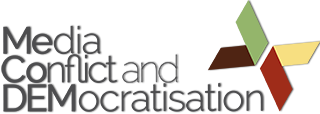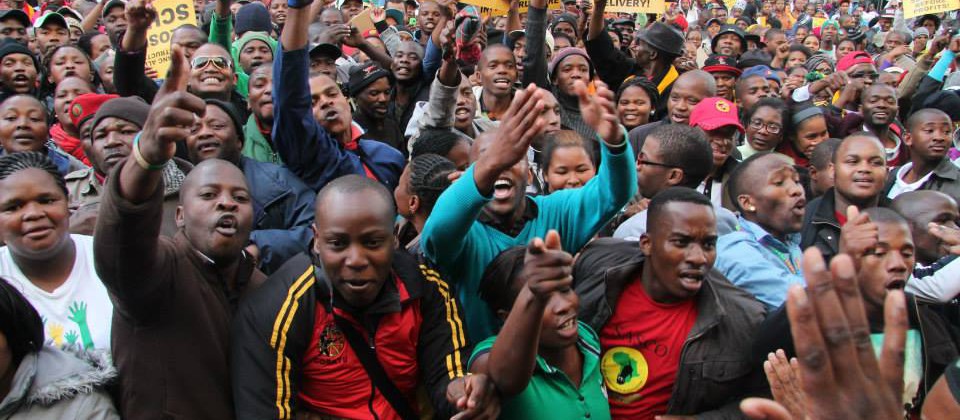- South Africa – an Overview
- South Africa’s Media Landscape
- Conflict Case 1: Citizenship and collective identities – Xenophobic violence
- Conflict Case 2: Distribution and control of power – Service delivery protests
- Conflict Case 3: Distribution and control of power – State of the Nation Address
South Africa – an Overview
South Africa has one of the most progressive constitutions in the world. The Bill of Rights guarantees a host of basic political, cultural and socio-economic rights, yet there have been persistent reports that citizen intolerance of non-citizens, refugees and migrants has escalated dramatically since 1994. Despite dramatic policy shifts since the first national democratic elections in 2004, the country has seen large-scale mass protests, marches, demonstrations, petitions and violent confrontations. Some of the reasons for this mass action are listed as municipal ineffectiveness in service delivery, and the poor responsiveness of municipalities to citizens’ grievances. Community protests are generally framed by media as demands for service delivery in response to what is seen as government’s failure to fulfill its technical functions. “This narrow view of conflicts between citizens and the state in post-apartheid South Africa is a result of the South African media’s dominant normative framework that defines its role as primarily in relation to the state rather than in relation to the citizenry”[1]. The media has generally been critiqued for biased reporting on political issues. Furthermore, commercial pressures often also result in the use of particular media frames. [1] mediaandcitizenship.ru.ac.za/youth-conflict-governance-and-the-media-south-african-perspectives/
South Africa’s Media Landscape
During apartheid, media was predominantly state-owned and controlled, but the sector experienced widespread liberalization after 1994. Public broadcast television is provided by the South African Broadcasting Corporation (SABC), there is one commercial broadcaster e.tv, and subscription satellite TV services are provided by MNet and DSTV, owned by Multichoice. There are also three pay-TV providers, introduced as an attempt to end MultiChoice Africa’s monopoly. Radio is the medium consumed by most South Africans, and there are several public broadcast SABC radio stations broadcasting in all 11 official languages. The SABC also owns several commercial radio stations in each major region, originally set up to fund the PSB service. There is one commercial talk radio station 567MW in Cape Town/Radio 702 owned by Primedia, and several privately owned music format radio stations. There are also a few privately owned online radio stations and over 80 community radio stations, owned and run by community-based organizations and run as non-profit organizations. The creation of a more diverse broadcast environment was a radical change to the state-owned and controlled apartheid era media.
The print media sector has 22 daily and 25 weekly newspapers, most published in English. There are a number of independent and community newspapers, though many are owned by the mainstream media companies and there is very little true community print media (although small commercial media titles do exist). The print industry is dominated by four large publishing groups, which own and control a large number of newspapers and magazines across the country. While the South African democracy is now 20 years old, it is still very much a country in transition. South Africa continues to grapple with a range of social and economic challenges that stem from its apartheid legacy.
Conflict Case 1: Citizenship and collective identities – Xenophobic violence
Between 2000 and 2008 around 67 people died in xenophobic attacks, and in May 2008 more than 70 people were killed and thousands of foreign residents were dislocated. While foreigners would have been subject to discrimination prior to the end of apartheid, there seems to have been a dramatic rise after 1994. Paradoxically, one of the effects of the ANC government’s policy of aggressive and inclusive nation-building has been a growth in intolerance towards outsiders. As a consequence, there is increased hostility against foreigners and African refugees which often turns into open violence. The media, especially the English speaking press, have increasingly come under attack, as their coverage is alleged of reproducing xenophobic language.
Conflict Case 2: Distribution and control of power – Service delivery protests
The term ‘service delivery protests’ describes a range of violent protests related to the inadequate provision of services by local municipalities, most often water, sanitation and housing. However, service delivery protests have to be understood more broadly as citizens’ claims for good governance in a context that remains to be marred by poverty and inequality. Linked to the service delivery protests is the rise of police brutality against protesters, which in most cases remains with impunity. Service delivery protests investigated as part of this conflict case include, but are not limited to Balfour (2009-2011) and Zamdela (2012-2013). In Balfour, Mpumulanga, for instance, conflicts arose as a result of an erratic and dirty water supply, constant power outages and unemployment. In the Zamdela informal settlement near Sasolburg in the Free State, in turn, residents called for the mayor to step down after he was accused of corruption. More recently the conflicts are about the proposed merger of Parys, a low-income area, into the municipality that governs Sasolburg, a relatively prosperous industrial area.
Conflict Case 3: Distribution and control of power – State of the Nation Address
While service delivery protests indicate conflicts over horizontal accountability, the SONA conflict encapsulates issues of vertical accountability, constitutionalism and the rights of the press in covering parliamentary affairs. This case evolved around the State of the Nation Address, delivered by President Jacob Zuma on 12 February 2015 to the South African parliament. As he was making his address, MPs of the Economic Freedom Fighters (EFF) interrupted him to ask when he would be paying back the money spent on his Nkandla home. The EFF members were removed from the National Assembly chamber by police and security personnel. The opposition regarded the use of policy in the National Assembly illegal and unconstitutional, and the Democratic Alliance walked out in protest. The event was also controversial because broadcasters were not allowed to show what was happening as EFF members were being removed, based on the so-called disorder clause to protect the dignity of the house, and several news outlets have campaigned to declare the ‘disorder clause’ unconstitutional.

